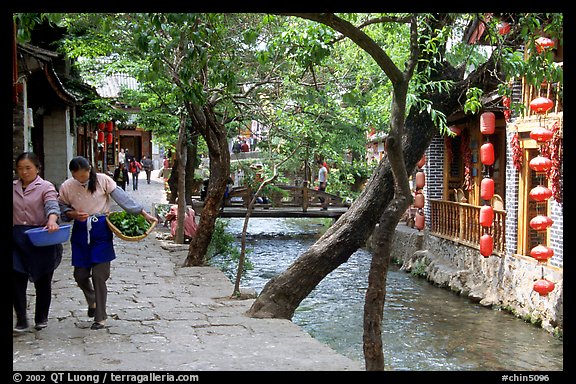In western Yunnan, in a broad valley 2000m up, close to the Himalayan foothills, sits the town of Lijiang. Upon arriving at the bus station one has to wonder why they bothered stopping there. But then all you have to do is walk down a street, turn down a couple of alleyways, and immediately you are transported hundreds of years back in time. I have never visited a town where the term "maze of alleyways" was more apt. The entirely pedestrian old town, with its cobbled streets, worn smooth with time, and old Naxi houses (more about them later) is a photographer's paradise (or it would be if it wasn't bloody overcast all the time!). The icing on the cake, though, is the dense network of mini streams and canals that flow parallel to the streets, sometimes taking up half the width between opposite houses. This is definitely one place in which getting lost isn't just a possibility, but a certainty.

Of course, such beauty hasn't gone unnoticed here in China. The Chinese, with their new found wealth, coupled with travel restrictions, are here en masse. Chinese tourists like their sites easy to digest, therefore the central square and the few alleyways leading off it are jam-packed from 9am, whereas just slightly further along the streets are empty. Another, hilariously kitsch, example of the above is the little town of Shuhe. The town, though beautiful in its way, is an entirely modern recreation of a "typical minority town" complete with its own circle of dancing grannies in traditional garb. The houses are meticulously built, but rather samey, with handy, open-plan downstairs areas housing various handicraft boutiques, whilst the rest of the house remains completely devoid of human habitation. The Chinese seem to lap it up though; especially enjoying the dancing grannies and the 10-minute horse rides.
If you remember back a couple of paragraphs I happened to mention the Naxi, who are the local minority group. All you ladies out there will love them, as they are a matriarchal society, where the women rule the roost. And although they are beginning to be outnumbered in the larger towns by Han (ethnic Chinese) they are ever-present in the villages in the area. One such village is Baisha, which is internationally famous (apparently) because of its favourite son, Dr Ho. He is known far and wide for his expertise in herbal medicine. He should also be known for his own little cult of personality thing that he has going. Any tourists that happen to pass his house (and, since there is only one street of any note in Baisha, all tourists pass by his house) get accosted by this wizened old figure, dressed in a white lab coat (bad lab practice that, to be wearing your lab coat outside, though I didn't have it in my heart to tell him), and pulled into his dingy house where he pushes various newspaper cut-outs and letters from random dignitaries at his unsuspecting victims. His latest treasure is the fact that Michael Palin stopped to visit on his latest travel programme where he tours the Himalayas (see here for excerpts from his book). Apparently he's pretty good at keeping cancers at bay, so just remember this tip just in case.
P.S. By the way, if anybody is planning to post a comment on my blog (don't all rush at once!) please e-mail me instead, as Big Brother won't allow me to view my own website. Boohoo!
No comments:
Post a Comment